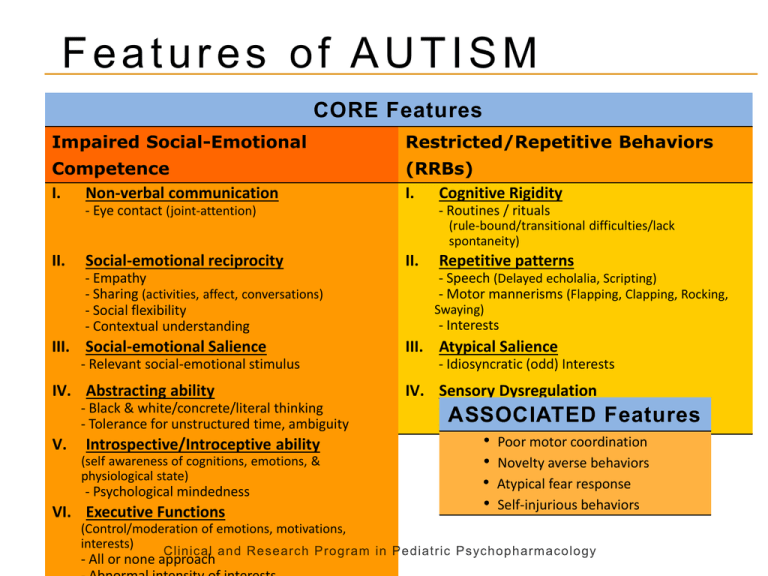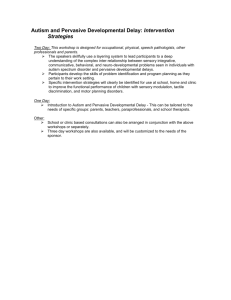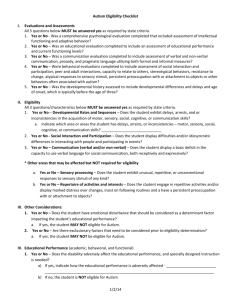What is Autism Spectrum Disorder
advertisement

Features of AUTISM CORE Features Impaired Social-Emotional Restricted/Repetitive Behaviors Competence I. Non-verbal communication (RRBs) I. Cognitive Rigidity - Eye contact (joint-attention) - Routines / rituals (rule-bound/transitional difficulties/lack spontaneity) II. Social-emotional reciprocity - Empathy - Sharing (activities, affect, conversations) - Social flexibility - Contextual understanding III. Social-emotional Salience - Relevant social-emotional stimulus IV. Abstracting ability - Black & white/concrete/literal thinking - Tolerance for unstructured time, ambiguity V. Introspective/Introceptive ability (self awareness of cognitions, emotions, & physiological state) - Psychological mindedness VI. Executive Functions (Control/moderation of emotions, motivations, interests) - All or none approach II. Repetitive patterns - Speech (Delayed echolalia, Scripting) - Motor mannerisms (Flapping, Clapping, Rocking, Swaying) - Interests III. Atypical Salience - Idiosyncratic (odd) Interests IV. Sensory Dysregulation - Atypical sensory perceptions/responses ASSOCIATED Features - Introsceptive ability • Poor motor coordination • Novelty averse behaviors • Atypical fear response • Self-injurious behaviors DSM Criteria for Autism Schizophrenic reaction - Childhood Type Schizophrenia - Childhood Type Infantile Autism Psychotic reaction Autistic, Atypical, & Infantile Autism DSM-I DSM-II DSM-III (1952) (1968) (1980) Pervasive Developmental Disorders Pervasive Developmental Disorders Autistic Autism Spectrum Disorder Autistic Autism Spectrum PDD-NOS Asperger's PDD-NOS Disorder DSM-III-R DSM-IV-R DSM-5 (1987) (1994/2000) (2013) - Greeting rituals - Rigid patterns of thinking DSM-5 Diagnostic Criteria for Autism A UTISM S PECTRUM D ISORDER ( 2 9 9 . 0 0 ) III Highly restricted, fixated interests that are abnormal in intensity or focus - Preoccupation with excessively circumscribed or perseverative interests IV Hyper- or hypo-reactivity to sensory input or unusual interest in sensory aspects of DSM-5 DIAGNOSTIC CRITERIA FOR AUTISM SPECTRUM DISORDER (299.00) A Persistent deficits in social interaction and communication all three of the following: as manifested by lifetime history of ______ I Deficits in social-emotional reciprocity - Inability to initiate or respond to social interactions - Inability to share affect, emotions, or interests - Difficulty in initiating or in sustaining a conversation II Deficits in nonverbal communicative behaviors used for social interaction - Abnormal to total lack of understanding and use of eye contact, affect, body language, and gestures - Poorly integrated verbal and nonverbal communication III Deficits in developing, maintaining, and understanding relationships - Difficulty in adjusting behavior to social contexts - Difficulty in making friends - Lack of interest in peers patterns of behavior, interests, or activities B Restricted, repetitive, and stereotyped _______ as manifested by lifetime history of at least two of the following: _ I Stereotyped or repetitive speech, motor movements, or use of objects - Motor stereotypies or mannerisms (lining up toys) - Echolalia, stereotyped, or idiosyncratic speech II Excessive adherence to sameness, routines, or ritualized patterns of verbal or nonverbal behavior - Transitional difficulties - Greeting rituals - Rigid patterns of thinking III Highly restricted, fixated interests that are abnormal in intensity or focus - Preoccupation with excessively circumscribed or perseverative interests IV Hyper- or hypo-reactivity to sensory input or unusual interest in sensory aspects of environment - Sensory integration issues - Apparent indifference to pain/temperature - Excessive smelling, touching, or visual fascination with lights or movements C Symptoms must be present in the early developmental period Symptoms may not fully manifest until social demands exceed limited capacities, or may be masked by learned strategies in later life. - Sensory integration issues - Apparent indifference to pain/temperature - Excessive smelling, touching, or visual fascination with lights or movements C Symptoms must be present in the early developmental period Symptoms may not fully manifest until social demands exceed limited capacities, or may be masked by learned strategies in later life. D Symptoms cause clinically significant impairment in functioning E These disturbances are not better explained by intellectual disability To make comorbid diagnoses of ASD & ID, social communication should be below that expected for general developmental level. Specify if: With or without accompanying intellectual impairment With or without accompanying language impairment Associated with a known medical or genetic condition or environmental factor Associated with another neurodevelopmental, mental, or behavioral disorder With catatonia Prevalence of Autism Spectrum Disorder Children with ASD ADDM Network 18 15 Prevalence per 1000 15 12 11 9 6 • Children 8 years old • Medical records reviewed by trained clinicians 7 7 8 9 3 0 15/100 7/100 0 2000 0 2002 2004 2006 2008 2010 Prevalence of ASD has more than DOUBLED between 2002 & 2010 and is increasing at the rate of 10 - 17% / year Centers for Disease Control & Prevention (CDC) Surveys: ADDM Network Surveys 2000, 2002, 2004, 2006, 2008, & 2010 Prevalence of ASD 18 15 12 9 6 3 0 2000 2002 2004 2006 2008 2010 Substantial rise in the prevalence of AUTISM in intellectually capable populations Centers for Disease Control & Prevention (CDC) Surveys: ADDM Network Surveys 2000, 2002, 2004, 2006, 2008, & 2010 Intelligence Profile in AUTISM Intellectual Disability Autism Spectrum Disorder [ID] Intelligence Quotient (IQ) High-Functioning With ID [Low-Functioning] 100 100 100 90 90 90 80 80 80 70 IMPAIRED IQ 60 60 50 40 70 IMPAIRE D IMPAIRE D 70 IMPAIRE D 60 IMPAIRE D 50 40 40 30 30 20 20 20 10 10 10 0 0 0 Social-Emotional Intelligence Intellectual Intelligence Social-Emotional Intelligence • Nonverbal • Asocial IMPAIRE D 50 30 Intellectual Intelligence INTACT Intellectual Intelligence Social-Emotional Intelligence • Verbal • Socially curious Social-emotion Competence Across the Lifespan Development of Social Competence (%) 100 Areas of Social-emotional Development 80 60 40 20 0 Preschool Latency Teenage (0–5 years) (6–12 years) (13–18 years) - Non-verbal communication skills - Social skills - Empathy - Abstracting ability - Cognitive Flexibility - Executive Control - Introspective ability Young Adult Adult (19–35 years) • Minimal social• Socially isolated • Social difficulties • ± Intellectual emotion demands success (friends, prom, dating) • Bullied • ± Superior • • Impaired intellectual • Impaired intellectual Challenges: intellectual capacity performance functioning -Social & relationship -transition to adulthood • Sensory • Present with ADHD • At risk for • At risk for drug Dysregulation depression, anxiety, abuse psychosis Social phase (≥36 years) • Delayed social milestones (marriage, children) • Social-emotional isolation • Suffer from anxiety & mood dysregulation Professional Phase







